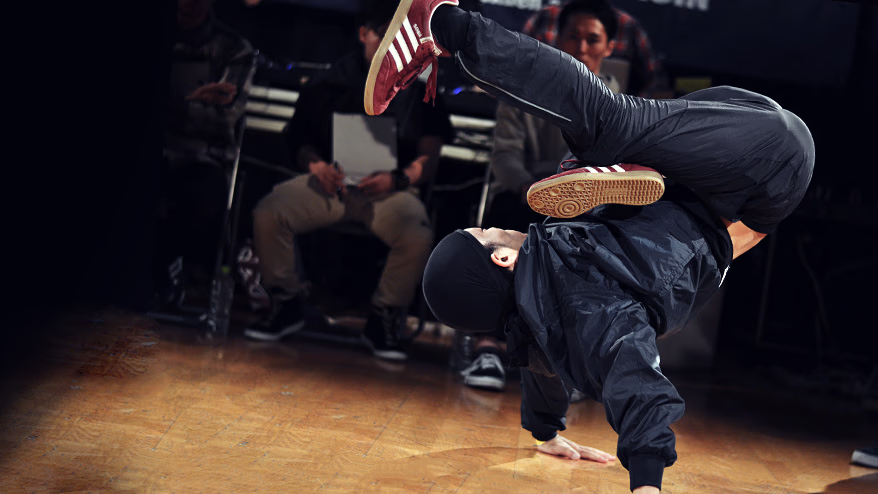こんにちは。デザイン部の上森です。
12年前からストリートダンス、なかでも「ブレイクダンス」と呼ばれるジャンルを踊っています。
3年前からデザイナーとして仕事をするようになり、生活の中心がダンスからデザインに切り替わりましたが、デザインってダンスに似てるなあと、ふと思うことがあります。
今回は、仕事をするなかで気づいた「ダンスとデザインの共通点」についてお話ししたいと思います。
1. ダンスもデザインもクリアにみせる

デザインは情報を伝えるにあたって、クリアであることが大切です。
クリアであるとは「わかりやすいかどうか」です。
例えば、
- 形や色、文字のサイズに緩急をつけてメリハリをだす。
- 情報が多く複雑なところは、間隔を開けたり、余白を作り、一度に目に入る情報の量やスピードを落としてあげる。
- 斬新なデザインは理解されづらいこともあるので、一般的なレイアウトの中にポイントで入れる。
ダンスをする時も「クリアかどうか」が私の中で重要です。
踊りで自分の表現を伝えるにあたり、デザインと似た手法をつかって、動きに緩急をつけてメリハリをつけたり、複雑な動きはスピードを落としてゆっくり見せます。
特に私の踊りは、他の人がやらない動きをする、オリジナリティを重視しています。
しかし目新しいものは、見る側にとっても見慣れない動きなので、何がすごいのかわかりづらくなります。
そこで、多くの人が見慣れた定番の動きをベースに、オリジナルの動きを加えた構成にします。
全ての動きにオリジナリティを出すのではなく、見慣れた動きに見慣れない動きを交えることで、一番見せたいオリジナルの部分を目立たせることができます。
"ここがウケどころですよ" とわかりやすく伝えるテレビのテロップと似ているかもしれません。
わかる人にはわかるマニアックさも良いですが、一人よがりになってしまわないためにも、わかりやすさを意識することが重要です。これはデザインにも共通して言えることだと思います。
2. 基礎力の向上から広がりがうまれる

デザインは、形、色、文字、レイアウトなど要素ごとに学問があるほど奥が深く、その知識と技術がデザインの基礎だと私は考えています。
仕事では、あらゆる業種のあらゆるテイストのデザインを作りますが、基礎力があってこそ、どんなデザインでも安定したクオリティを担保することができます。
それには気づいたのは、ダンスにおいても基礎が重要だったからです。
ダンス界ではトレンドがよく移り変わりますが、実のところトレンドとは、昔流行ったスタイルに少し戻ったり、新しいことを少しカスタマイズするだけだったりします。
つまり、踊りとしての基礎の部分は変わらず、基礎を崩したり、付け加える調整といえます。
ダンサーにとって、基礎は時代への対応力(※)として重要であり、基礎がなければ、時代への調整がきかなくなり、一発屋になりかねません。
(※自己表現としてどの程度トレンドを取り入れるかは別の話ですが)
基礎は「粘土」に例えられるでしょうか。
粘土は色んな形を作ることができますが、粘土自体の質を良くしないと、ひび割れたり、くっつかなかったり、作りたい形が作れません。
粘土自体の質の向上や、粘土自体を大きくしていくと、そこから生まれるものの広がりが違うのです。
私自身、基礎を軽視し、クセを「味」として捉えてもらおうと考えた時期もありましたが、そこからの広がりはなく、その味も飽きられました。しかし、基礎があれば意図して味を出すことができます。基礎を崩すだけですから。
基礎を崩したり付け加えることでトレンドへの調整をしたり、踊りの味をだす作業は、基礎をもとに様々な案件のテイストを作るデザインと似たものがあります。基礎を崩したり付け加える調整の幅が、デザインのテイストの幅なのかもしれません。
また、基礎=根本的なこと、応用=調整と考えると、基礎力の向上こそデザイン力の向上ともいえます。学生の頃学んだ平面構成や色彩学、タイポグラフィー、デッサンなどをより深く学びたいと思う今日この頃です。
3. 適応力で生き残る

厳しい納期や予算など、デザイナーの仕事には制限がつきものです。
しかし、そんな状況でも結果をださなければなりません。
最初は不満もありましたが、デザイナーでもダンサーでも結果を出している人を見ると「状況への適応力」の問題だと気づかされます。
ブレイクダンスは床に手をついたり、転がったりする動きが多いですが、大会の会場によっては、フロアが狭かったり、床が滑る、ベタベタする。なにか鉄の部品が突出している(笑)。
アーティストのPV撮影では、「ここで踊ってください」と言われた場所が凸凹のコンクリートだったりするのです。
能力を100%発揮できる環境が用意されることはなかなかありません。
しかしそれを嘆くよりも、厳しい環境に適応できる方が、適応できないダンサーに勝つためのチャンスにもなったのです。
"生き残る"ってこういうことだなぁ。なんて思っています。
4. 細分化して組み立て直す

難しそうにみえるビジュアル制作、複雑そうなプログラミング、大型案件のディレクションなど、自分にはできそうにないと思ってしまいがちです。
しかし、ダンスのことを思い出すと、いやいや、と考えなおすのです。
ブレイクダンスでも派手な回転をしたり、飛んだり跳ねたりする技があり、最初はできるはずがないと思ってしまいがちです。
しかし、動きを分析して細分化していくと、今の自分でもできる部分があることに気づきます。
たとえば「歯磨き」の動作を分析すると
- 歯ブラシをもつ
- 歯磨き粉をつける
- 口の中にいれる
- 上下にうごかす
このように動作を細かく分解して考えれば、必ずできるようになるのです。
2 はまだできないが、今できる 1 を続けていくうちに体と頭が慣れ、2 への準備が整い、気づいたら簡単に 2 が出来る。そしたら次は 3 へ...。
歯磨きの例は、キッズダンサーに教える時によく使ったフレーズなので単純すぎますが、デザイナーの仕事にも同じようなことがいえると思います。
「ひとつの大きなもの」は「小さい何かの集合体」です。
その小さい何かの関連性に気づき、ひとつずつ組み立て直すことで、ひとつの大きなものができあがるのです。
ダンスを突きつめることで気づいたこと
今回、ダンスとデザインとの共通点をあげましたが、ひとつのことを長く続けて気づいたことは、他のことにも活かせると思っています。
多くのことを少しずつかじることも、いろいろな共通点が見つかって楽しいですが、ひとつのことを長く続けることで、より深い、揺るぎない原則のようなものが見つかるのではないでしょうか。
言い古されたことかもしれませんが、ダンスを長く続けてきた経験が、その重要性を気づかせてくれました。
大会の結果や、ダンサーとしての評価よりも、そこに到達するまでの過程に得るものが多かったということ。
それは目標まで試行錯誤を続けたから気づけたことであって、何となくダラダラやっていたら得るものは少なかったと思います。
今後も、デザインを突き詰める上で目標をしっかりと持って、目標までの試行錯誤を楽しもうと思います。

